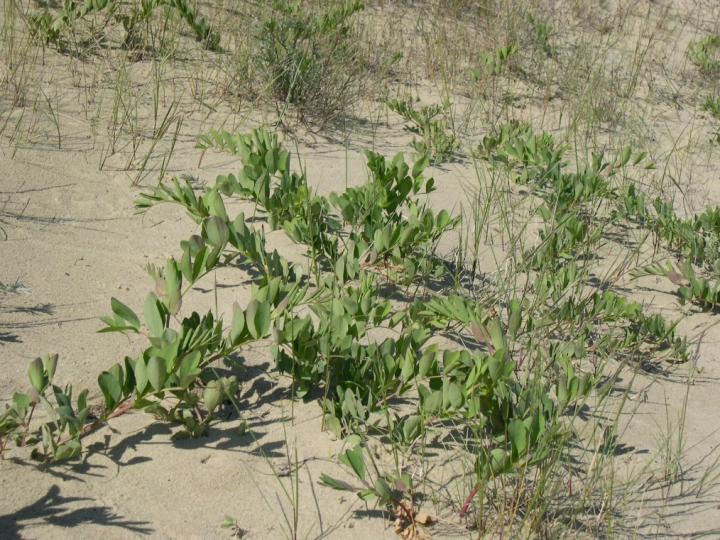IKBFU Institute of Living Systems biology scientists study protective mechanisms of the Curonian Spit wild plants.

Credit: Dr. Maslennikov
IKBFU Institute of Living Systems biology scientists study protective mechanisms of the Curonian Spit wild plants. The scientists are particularly interested in a beach pea plant (Lathyrus maritimus Bigel). This plant is constantly affected by ultraviolet rays, high humidity, low temperature, high salinity in the water, and many other factors. The plant can be viewed as a fine example of ecological adaptation, but the mechanism of the adaptation has not been thoroughly studied yet. The beach pea grows closer to the seaside on Curonian Spit foredunes’ leeward side. The plant blooms in June and August, yields in August and September. It is sometimes used as cattle fodder. Unlike other legumes, it is not cultivated, partly due to a lack of study of its nutritional and antioxidant value and the possible presence of toxins. However, according to employees of the Laboratory of Natural Antioxidants of the Institute of Living Systems, the plant, due to its antioxidant properties, is promising for use in biotechnology and agriculture.
It is worth noting that the research was carried out with wild plants directly, away from the comfort of a laboratory.
Pavel Maslennikov, Associate Professor at the IKBFU Institute of Living Systems:
“Wild plants that have not been subjected to directed selection may differ significantly from the model ones in terms of the constitutive or stress-induced level of known adaptive reactions. Such studies of wild species allow us to expand our knowledge of the general laws of protective response under stress conditions”.
The research of the scientists is based on the study of the antioxidant system of plant protection, in particular – low-molecular antioxidants, which are extremely diverse and belong to different classes of chemical compounds.
Dr. Maslennikov also added:
«Our work has studied the accumulation of ascorbic acid (AA) and its derivatives, as well as water-soluble antioxidants and antioxidant enzymes in the leaves of the coastal rank. The content of metals and active oxygen forms in the leaves of plants on the windward and leeward sides of the foredune was analyzed. Soil (temperature, humidity, TM) was analyzed, wind speed and air humidity were measured. Growing conditions of plants from the windward side of the foredune are less favorable than from the leeward side: constant mechanical influence of wind from the seaside, chloride salinization, lower temperatures, lower humidity of soil can cause oxidative stress in plants. Under these conditions, the accumulation of low-molecular antioxidants – ascorbic acid – significantly increases the adaptation of plants to adverse conditions on the windward side of the foredune».
The study of scientists also showed that the level of ascorbic acid derivatives to a large extent also prevailed in plants on the windward side of the foredune (seaside). Phenological phases of development in these plants came one or two weeks later than in plants on the leeward side.
The study results are important both for the development of biocoenosis conservation strategy and for the knowledge base about the nature of the protective response in wild plants and the limits of their survival under changing natural conditions.
###
The research supported by the Competitiveness Enhancement Program of the IKBFU was carried out by Pavel Maslennikov and Elena Golovina, researchers at the Institute of Living Systems, and Anastasia Artyomenko, a student of the Institute. The results were published in the Plants scientific journal.
Media Contact
Denis Zhigulin
[email protected]
Original Source
https:/
Related Journal Article
http://dx.




